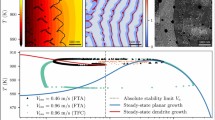Abstract
Crack propagation behaviors in a precracked single crystal Ag under mode I loading at different temperatures are studied by molecular dynamics simulation. The simulation results show that the crack propagation behaviors are sensitive to external temperature. At 0 K, the crack propagates in a brittle manner. Crack tip blunting and void generation are first observed followed by void growth and linkage with the main crack, which lead to the propagation of the main crack and brittle failure immediately without any microstructure evolution. As the temperature gets higher, more void nucleations and dislocation emissions occur in the crack propagation process. The deformation of the single crystal Ag can be considered as plastic deformation due to dislocation emissions. The crack propagation dynamics characterizing the microstructure evolution of atoms around the crack tip is also shown. Finally, it is shown that the stress of the single crystal Ag changes with the crack length synchronously.







Similar content being viewed by others
References
C.B. Cui and H.G. Beom: Molecular dynamics simulations of edge cracks in copper and aluminum single crystals. Mater. Sci. Eng., A 609, 102 (2014).
S.W. Xu and X.M. Deng: Nanoscale void nucleation and growth and crack tip stress evolution ahead of a growing crack in a single crystal. Nanotechnology 19, 115705 (2008).
C.S. Becquart, D. Kim, J.A. Rifkin, and P.C. Clapp: Fracture properties of metals and alloys from molecular dynamics simulations. Mater. Sci. Eng., A 170, 87 (1993).
F.F. Abraham and H. Gao: Anomalous ductile-brittle fracture behaviour in fcc crystals. Philos. Mag. Lett. 78, 307 (1998).
H. Kimizuka, H. Kaburaki, F. Shimizu, and J. Li: Crack-tip dislocation nanostructures in dynamical fracture of fcc metals: A molecular dynamics study. J. Comput.-Aided Mater. Des. 10, 143 (2003).
W.P. Wu and Z.Z. Yao: Molecular dynamics simulation of stress distribution and microstructure evolution ahead of a growing crack in single crystal nickel. Theor. Appl. Fract. Mech. 62, 67 (2012).
H. Krull and H. Yuan: Suggestions to the cohesive traction–separation law from atomistic simulations. Eng. Fract. Mech. 78, 525 (2011).
A. Needleman: An analysis of decohesion along an imperfect interface. Int. J. Fract. 42, 21 (1990).
V. Yamakov, E. Saether, D.R. Phillips, and E.H. Glaessgen: Molecular-dynamics simulation-based cohesive zone representation of intergranular fracture processes in aluminum. J. Mech. Phys. Solids 54, 1899 (2006).
Y. Cheng, Z.H. **, Y.W. Zhang, and H. Gao: On intrinsic brittleness and ductility of intergranular fracture along symmetrical tilt grain boundaries in copper. Acta Mater. 58, 2293 (2010).
P. White: Molecular dynamic modelling of fatigue crack growth in aluminum using LEFM boundary conditions. Int. J. Fatigue 44, 141 (2012).
Y. Cheng, M.X. Shi, and Y.W. Zhang: Atomistic simulation study on key factors dominating dislocation nucleation from a crack tip in two FCC materials: Cu and Al. Int. J. Solids Struct. 49, 3345 (2012).
Y. Zhou, Z. Yang, and Z. Lu: Dynamic crack propagation in copper bicrystals grain boundary by atomistic simulation. Mater. Sci. Eng., A 599, 116 (2014).
L.G. Sun, X.Q. He, J.B. Wang, and J. Lu: Deformation and failure mechanisms of nanotwinned copper films with a pre-existing crack. Mater. Sci. Eng., A 606, 334 (2014).
G.P. Potirniche, M.F. Horstemeyer, P.M. Gullett, and B. Jelinek: Atomistic modelling of fatigue crack growth and dislocation structuring in FCC crystals. Proc. R. Soc. A 462, 3707 (2006).
W.P. Wu and Z.Z. Yao: Influence of a strain rate and temperature on the crack tip stress and microstructure evolution of monocrystalline nickel: A molecular dynamics simulation. Strength Mater. 46, 164 (2014).
J. Zhang and S. Ghosh: Molecular dynamics based study and characterization of deformation mechanisms near a crack in a crystalline material. J. Mech. Phys. Solids 61, 1670 (2013).
P.B. Chowdhury, H. Sehitoglu, R.G. Rateick, and H.J. Maier: Modeling fatigue crack growth resistance of nanocrystalline alloys. Acta Mater. 61, 2531 (2013).
M. Soleymani, M.H. Parsa, and H. Mirzadeh: Molecular dynamics simulation of stress field around edge dislocations in aluminum. Comput. Mater. Sci. 84, 83 (2014).
M.S. Daw, S.M. Foiles, and M.I. Baskes: The embedded-atom method: A review of theory and applications. Mater. Sci. Rep. 9, 251 (1993).
P.L. Williams, Y. Mishin, and J.C. Hamilton: An embedded-atom potential for the Cu–Ag system. Model. Simul. Mater. Sci. Eng. 14, 817 (2006).
S. Nosé: A unified formulation of the constant temperature molecular dynamics methods. J. Chem. Phys. 81, 511 (1984).
S. Plimpton: Fast parallel algorithms for short-range molecular dynamics. J. Comput. Phys. 117, 1 (1995).
A. Stukowski: Visualization and analysis of atomistic simulation data with OVITO–the open visualization tool. Model. Simul. Mater. Sci. Eng. 18, 015012 (2010).
D. Faken and H. Jónsson: Systematic analysis of local atomic structure combined with 3D computer graphics. Comput. Mater. Sci. 2, 279 (1994).
H. Tsuzuki, P.S. Branicio, and J.P. Rino: Structural characterization of deformed crystals by analysis of common atomic neighborhood. Comput. Phys. Commun. 177, 518 (2007).
ACKNOWLEDGMENTS
This wok was fully supported by a grant from the City University of Hong Kong (Project No. 9680086), China Nature Science Foundation (11372281) and Zhejiang Province Nature Science Foundation (LY13A020003, LQ13A020002). The authors are grateful for the financial supports.
Author information
Authors and Affiliations
Corresponding author
Rights and permissions
About this article
Cite this article
Liu, X.F., Wang, J.B., Sun, L.G. et al. Investigation on crack propagation in single crystal Ag with temperature dependence. Journal of Materials Research 30, 3553–3563 (2015). https://doi.org/10.1557/jmr.2015.325
Received:
Accepted:
Published:
Issue Date:
DOI: https://doi.org/10.1557/jmr.2015.325




